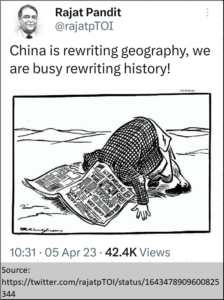Without economic growth, India’s population bonanza means nothing
RN Bhaskar
There was almost a collective whoop of joy in India when the UN came out with its report showing that India’s population had now exceeded China’s. But the actual picture could be messy because of the sins of commission and omission by successive governments.

 There is a possibility that China may be able to cope with its declining population. Do look up the analysis by J Mulraj (https://asiaconverge.com/2023/04/china-is-an-enigma/) where he talks about how China has succeeded in automating even its ports (https://youtu.be/A3jTXC67BEA). India, on the other hand, may not be able to cope with its rising numbers (which are expected to peak only in 2060).
There is a possibility that China may be able to cope with its declining population. Do look up the analysis by J Mulraj (https://asiaconverge.com/2023/04/china-is-an-enigma/) where he talks about how China has succeeded in automating even its ports (https://youtu.be/A3jTXC67BEA). India, on the other hand, may not be able to cope with its rising numbers (which are expected to peak only in 2060).
Lok Sabha documents show how India’s government schools account for a terrible GER of just 27% (https://asiaconverge.com/2023/04/the-state-of-education-in-india/), as many as 1.17 lakh one-teacher schools, only 14% of schools with internet facilities and only 48% of its schools with science laboratories (how do they teach chemistry? With gas stoves and kitchen utensils?). A poorly educated population can be fodder for more riots, and mayhem. It gives India’s policy makers more excuses to spend more legislative time on rewriting history, changing names of cities and roads, and talking about higher marks for students who know their Sanskrit hymns.
The best indicator of poor health services is the manner in which India’s life expectancy is lower than that of the global average, and much lower than that of China. India has abused its demographic potential.
Nothing could be more eloquent than a Twitter feed.
Undoubtedly, different folk have different perspectives about this country’s population. Many in the RSS has not shied away from publicly declaring that India should adopt a two-child policy, enforceable by law (https://www.hindustantimes.com/india-news/rss-to-shift-focus-to-two-child-policy-says-mohan-bhagwat/story-19zglEFSvIZrf1KIEDM9HL.html). This would have been acceptable if only they had first insisted on better education, healthcare, and employment.
Studies have shown, in India and across the world, that the best way to reduce population growth is through education and economic empowerment. When these are missing, families tend to have more children, expecting some to die during their very infancy. There is more security in numbers.
Watch the demographic profiles region-wise in India. The poorest states have the highest birth rates. The relatively affluent South has lower birthrates. This reduced total fertility rate (TFR) has given rise to fears that they are getting marginalised in an already polarized society where the relatively poor and illiterate Hindi speaking belt seeks to enforce its culture and language over the South.
 In fact, the government has not even fared well when it comes to its premier educational institutions – the IITs, IIMs and medical colleges (https://bhaskarr.substack.com/p/the-state-of-higher-education-in).
In fact, the government has not even fared well when it comes to its premier educational institutions – the IITs, IIMs and medical colleges (https://bhaskarr.substack.com/p/the-state-of-higher-education-in).
Literacy and growth
And this is where India’s policymakers need to study global fertility rates very carefully. Watch the investments being poured into the African continent. Watch literacy levels rise. With a high TFR, growing education and better healthcare, it will not be long before Africa begins to take away the jobs and wealth generation opportunities that India has been aspiring for (https://asiaconverge.com/2021/06/can-africa-become-the-new-market-to-stump-india/).
Already, country like Bangladesh has, despite a significantly higher population density (almost 2a .5 times more than India’s), managed to account for a higher per capita GDP than India. This is truly shameful, considering that Bangladesh got its independence in 1971, and was reckoned to be a basket case till a decade ago (https://asiaconverge.com/2022/05/bangladesh-trounces-india/).
Having a demographic dividend is a good thing, provided that the population has jobs, education, and healthcare. That is something India appears to have overlooked. The disdain with which India’s policymakers treat the masses is frightening. How else could one explain the Kharghar tragedy which accounted for at least 14 lives (https://www.msn.com/en-in/news/newsindia/kharghar-tragedy-sharad-pawar-says-gross-negligence-led-to-loss-of-lives/ar-AA1ab3gF). Politicians and their organisers left thousands to swelter under the blazing sun, while the privileged sat in covered areas. The callousness was underscored when some in the administration tried to pass around a story that those who died had co-morbidities, which autopsy reports debunked (https://www.newindianexpress.com/nation/2023/apr/21/kharghar-tragedy-autopsy-reports-confirm-victims-died-of-sunstroke-2568062.html). The disdain for the populace couldn’t find a better expression.
 India’s scores are low even on maternal mortality – another indication of the scant attention given either to medical education or healthcare.
India’s scores are low even on maternal mortality – another indication of the scant attention given either to medical education or healthcare.
In other words, if India wants to be a global leader, a large population can help. Even one rupee collected from each individual towards indirect taxes like GST brings the government 1.4 billion rupees. That is why India remains a rich country where, unfortunately, most of its people remain poor. But the number to watch is per capita income, and life expectancy. When these numbers remain low, you can be sure that the government is not doing its job properly.
The author is a senior journalist and researcher






































COMMENTS